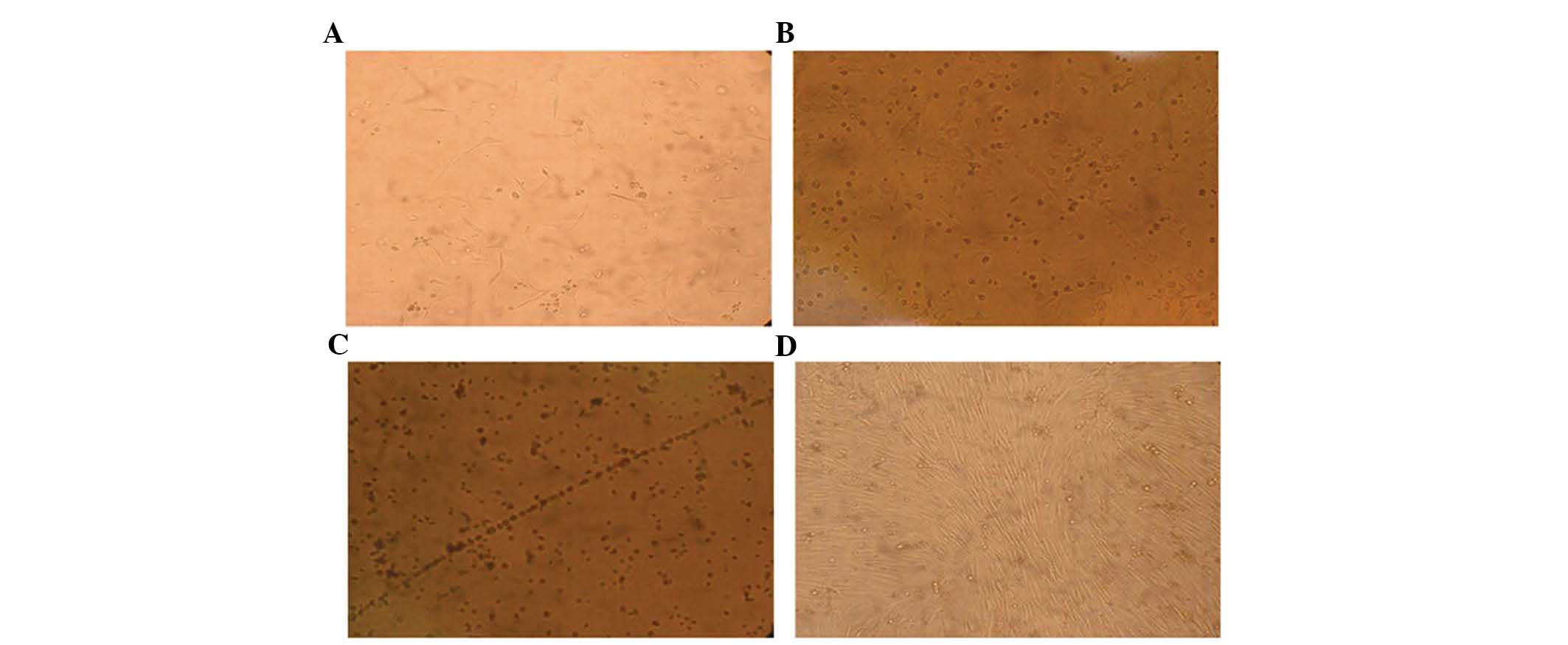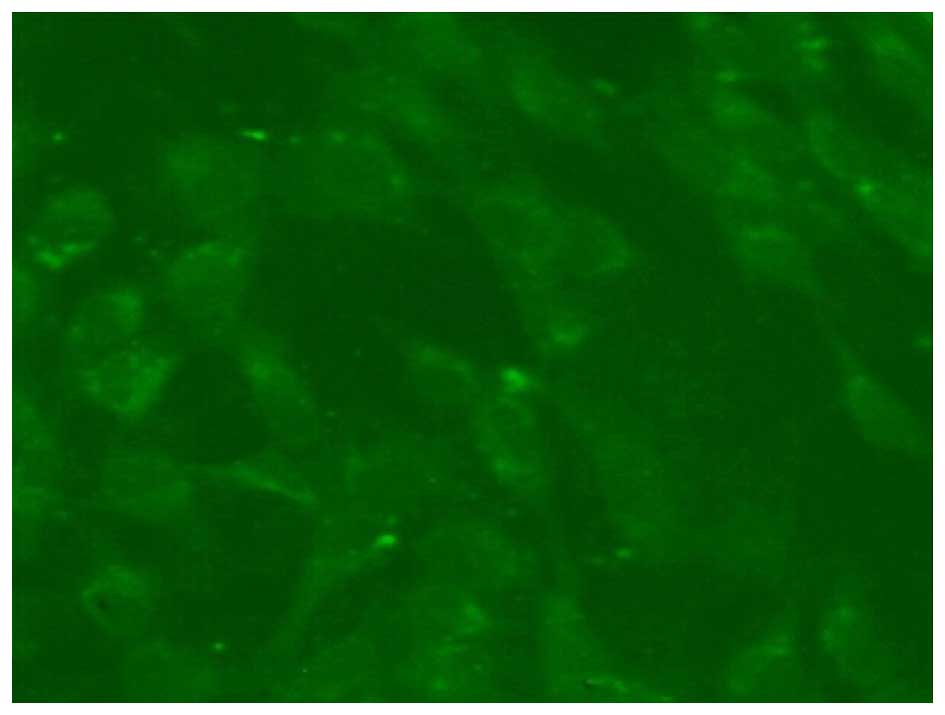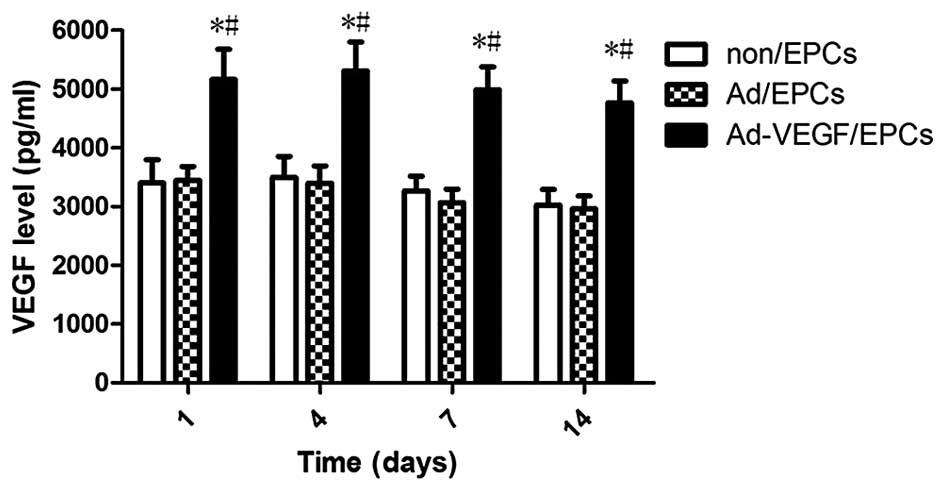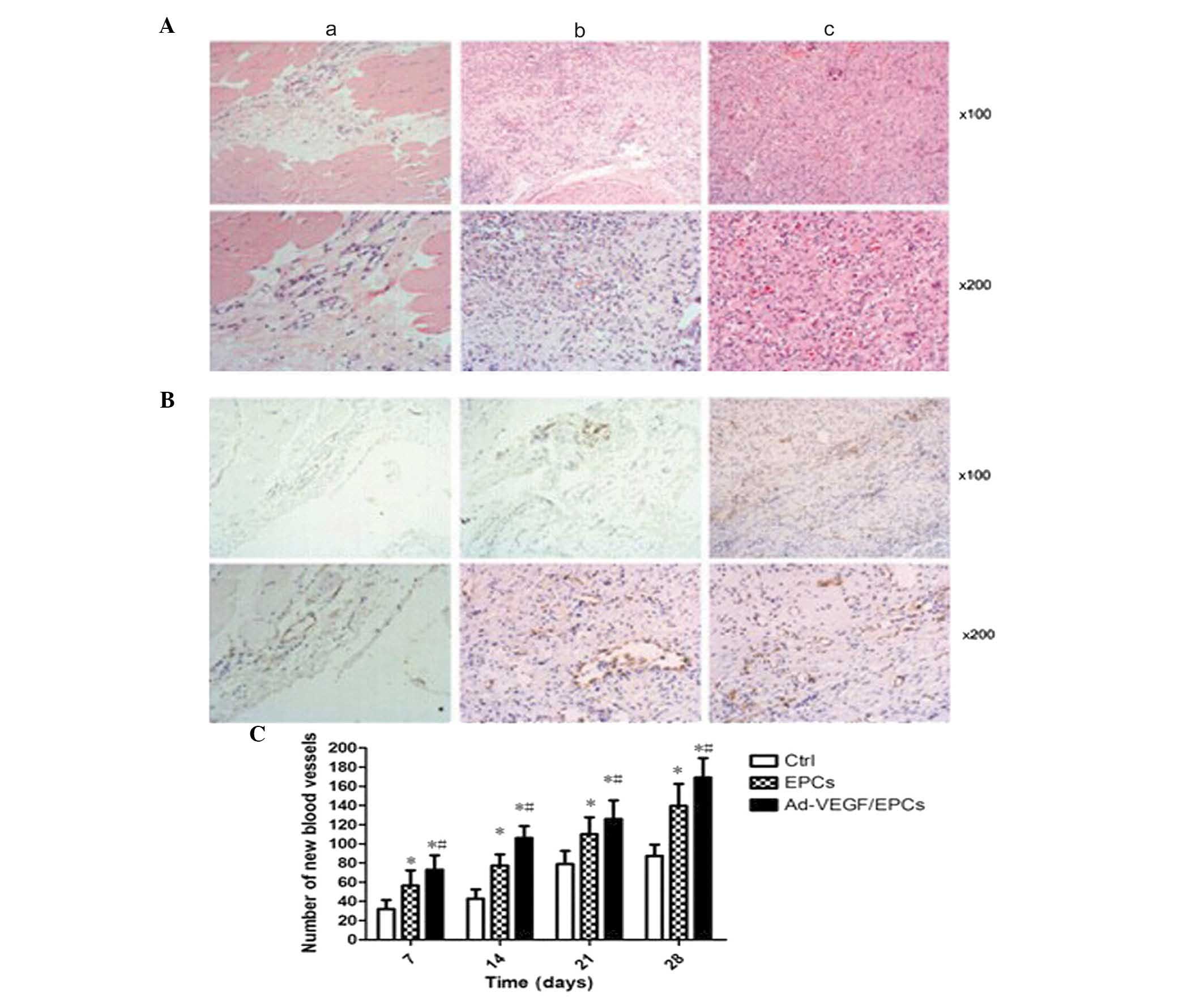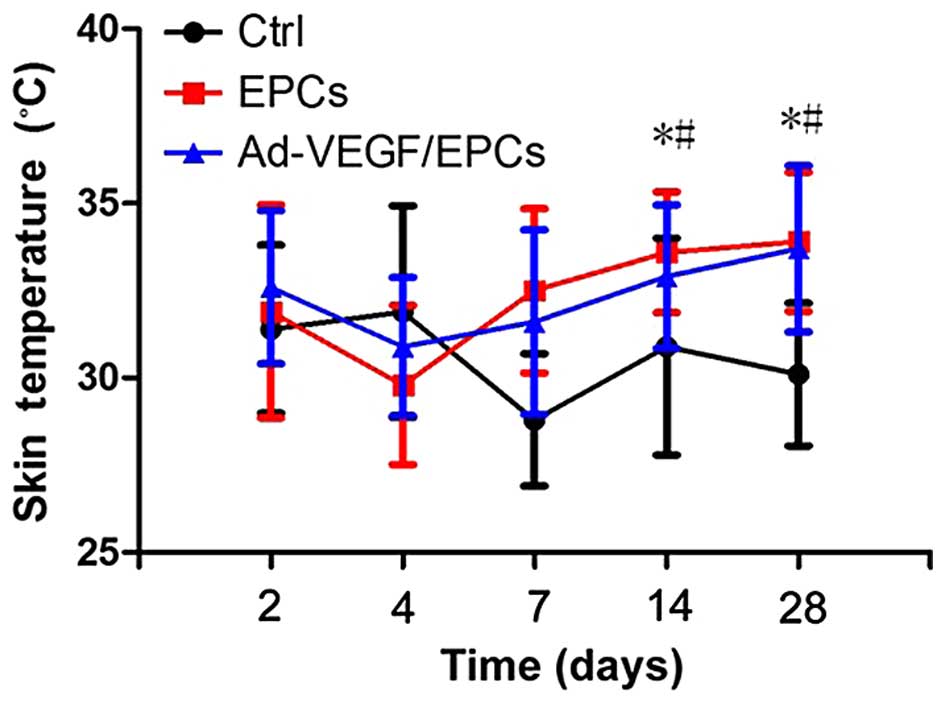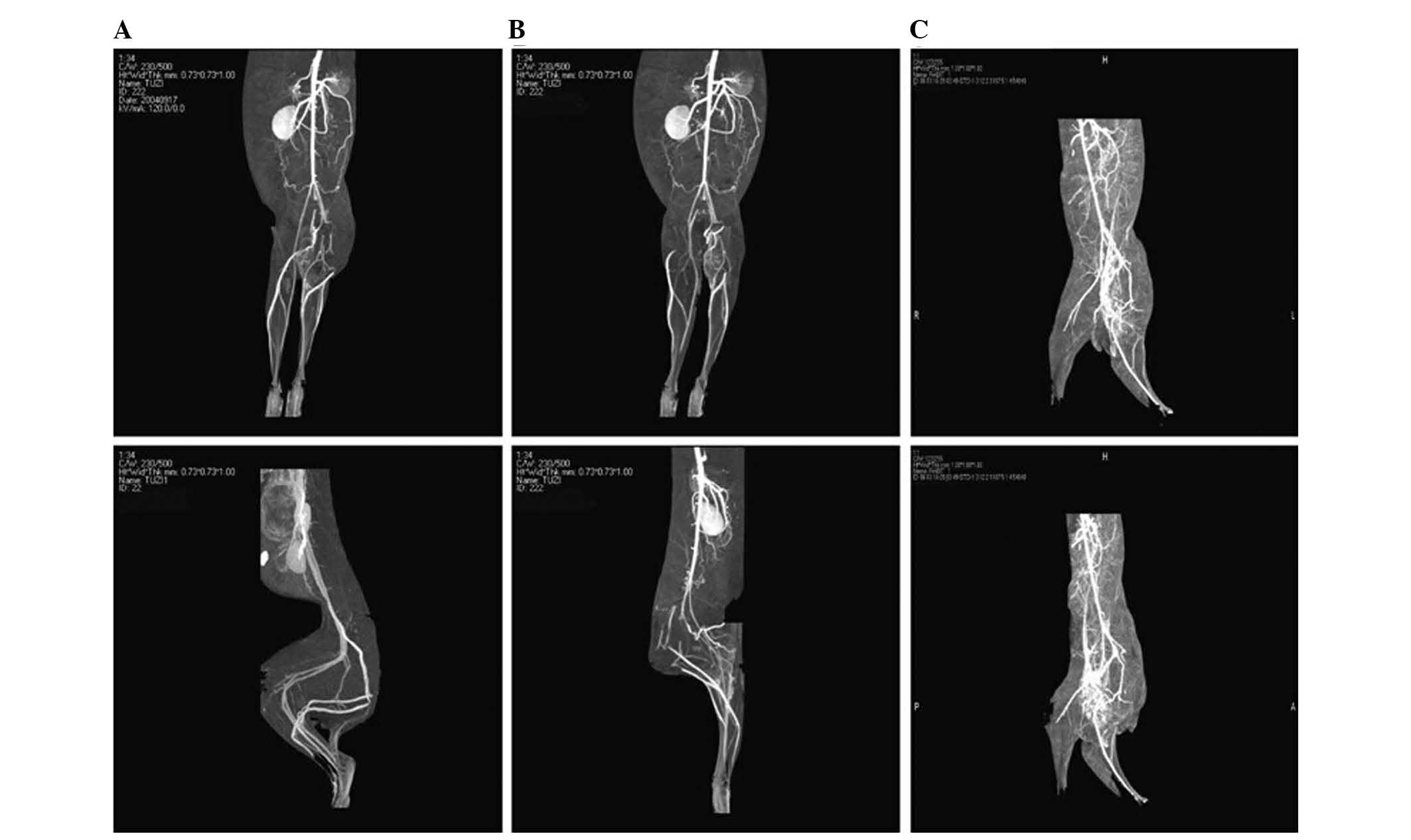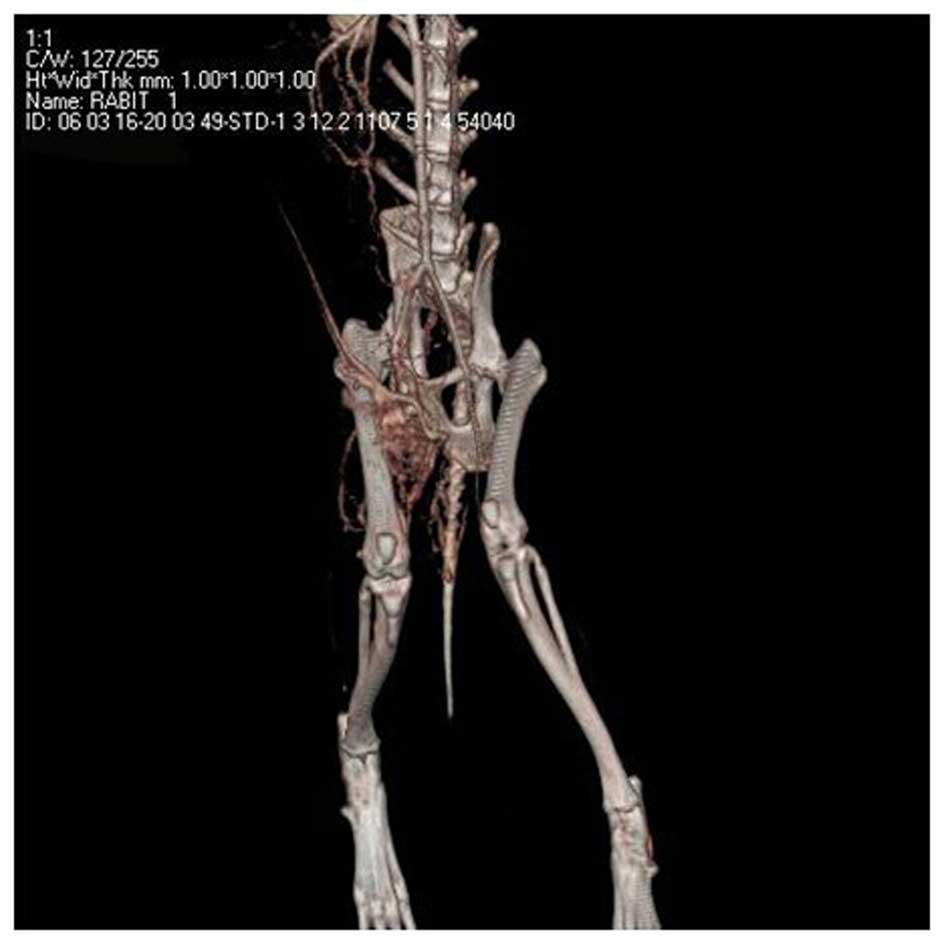Transplantation of vascular endothelial growth factor 165‑transfected endothelial progenitor cells for the treatment of limb ischemia
- Authors:
- Published online on: July 20, 2015 https://doi.org/10.3892/mmr.2015.4100
- Pages: 4967-4974
-
Copyright: © Wang et al. This is an open access article distributed under the terms of Creative Commons Attribution License.
Abstract
Introduction
Limb ischemia is deleterious to human health, and many patients are not suitable for surgical treatment due to various factors, including anatomy. Therefore, the prognosis of limb ischemia is poor, and causes great discomfort. In addition, therapeutic strategies are rarely successful, leading to limb amputation in many patients, specifically those who suffer from severe pain. Increasing the levels of angiogenesis and improving circulation in ischemia limbs may provide the most effective treatment, and is thus the subject of numerous studies (1,2). Stem cell transplantation in the treatment of ischemic diseases has recently been investigated by numerous studies (3,4), with animal model experiments and clinical studies being carried out in order to elucidate the effects of stem cell transplantation on ischemic diseases.
Stem cell transplantation has limitations, predominantly associated with the quality and quantity of endothelial progenitor cells (EPCs), which requires improvement in order for treatment to be successful. Using genetic engineering to improve the quality of EPCs, thus reducing the dosage of EPCs required for transplantation, may provide a promising method of limb ischemia treatment.
Vascular endothelial growth factor (VEGF) is an endothelial cell-specific growth factor and a regulator of physiological and pathological angiogenesis. In addition, VEGF is able to increase the permeability of capillary vessels to different macromolecules. VEGF consists of a family of polypeptide isoforms generated from a single-copy gene by alternative splicing of the primary transcript. VEGF is secreted by intact cells as a dimer of the four isoforms of 121, 165, 189, and 206 amino acids and are secreted from cells via a poorly characterized pathway (5). In the present study, in vitro EPCs were obtained from the differentiation of bone marrow mononuclear cells (BM-MNCs) extracted from New Zealand rabbits. VEGF165 gene transfection was subsequently performed, and the cells were transplanted into New Zealand rabbits with ischemic hind limbs. The levels of neovascularization and the effects of transplantation on limb ischemia were detected. The present study aimed to provide an experimental basis for the clinical application of stem cells and gene therapy in the treatment of ischemic diseases.
Materials and methods
Animals
New Zealand rabbits (age, 3–4 months) were obtained from the Animal Laboratory of Beijing Institute of Heart Lung and Blood Vessel Diseases (Beijing, China). The animals were maintained at a room temperature of 20–22°C and humidity of 40–70% under a 12-h light/dark cycle, with access to food and water ad libitum. The study was approved by the ethics committee of Beijing Anzhen Hospital, Capital Medical University (Beijing, China).
EPC isolation, culture, and identification
New Zealand rabbits were intravenously injected via the marginal ear vein with 3% sodium pentobarbital (30 mg/kg; Beijing Tianlai Biologic Products, Inc., Beijing, China), and bilateral iliac crest multipoint punctures were performed prior to marrow fluid aspiration. The quantity of bone marrow obtained from a single puncture was ~10–15 ml. Gradient centrifugation was performed in Ficoll (Sigma-Aldrich, St. Louis, MO, USA) in order to separate the mononuclear cells. The cells were then plated onto culture dishes in M199 culture medium (Gibco Life Technologies, Carlsbad, CA, USA) supplemented with 15% fetal bovine serum (GE Healthcare Life Sciences, Logan, UT, USA), 20 µg/ml VEGF (PeproTech EC Ltd., London, UK), 2 µg/ml alkaline fiber cell growth factor (bFGF; PeproTech EC Ltd.), 2 µg/ml insulin-like growth factor-1 (IGF-1; PeproTech EC Ltd.), and half of the medium was changed every 3–4 days.
Following 10 days of culture, the cells were collected and fixed in sections, prior to being observed under a transmission electron microscope (TEM; JEM-1010; JEOL., Ltd., Tokyo, Japan). The cells were fixed and mounted onto slides following 14 days of culture, and indirect immunofluorescence was carried out using the following primary antibodies: Rabbit-anti-von Willebrand factor (vWF) polyclonal antibody (sc14014; Santa Cruz Biotechnology, Inc., Dallas, TX, USA), and rabbit-anti-CD133 monoclonal antibody (ab19898; Abcam plc, Cambridge, UK), and the following secondary antibodies: Fluorescein isothiocyanate (FITC)-labeled goat-anti-rabbit antibody (sc3839; Santa Cruz Biotechnology, Inc.), and tetramethylrhodamine (TRITC)-labeled goat-anti-rabbit antibody (sc3841; Santa Cruz Biotechnology, Inc.). All dilutions were 1:200.
In vitro gene transfer in EPCs
Following 14 days in culture, the EPCs were transfected with a recombinant VEGF165-encoding gene (Ad-VEGF165) using Lipofectamine 200 (Invitrogen Life Technologies, Carlsbad, CA, USA), and post-transfection, the cells were incubated at 37°C in an atmosphere containing 5% CO2 for 2 h. Three multiplicities of infection (MOI; 10, 50, and 100) were used, and cellular proliferation was assessed by MTT assay (Sigma-Aldrich). A total of 20 ml MTT solution (5 mg/ml) was added to each well, and colorimetric assays were conducted at λ=570 nm following incubation for 4 h. Following experimentation, the EPCs were transfected with 50 MOI Ad/VEGF165, and the transfection efficiency was measured by fluorescence using a bx51m fluorescence microscope (Olympus Optical Co., Ltd., Tokyo, Japan). EPCs were transfected with either Ad or Ad-VEGF165, and the proliferative activity of the non-transfected cells (non/EPCs), Ad-transfected EPCs (Ad/EPCs), and Ad-VEGF165-transfected EPCs (Ad-VEGF/EPCs) was evaluated.
Analysis of the protein expression levels of VEGF by ELISA
On days 1, 4, 7, and 14 following gene transfer, the Ad-VEGF165/EPCs, Ad/EPCs, and non/EPCs were reseeded (5×103/200 µl/well), and the supernatant was collected. The protein expression levels of VEGF were detected using an ABC-ELISA (Beijing Jingmei Biologic Products, Inc., Beijing, China) with the supernatant as the sample.
Establishment of a New Zealand rabbit model with hind limb ischemia
Sodium pentobarbital was intravenously injected into the marginal ear vein of male New Zealand rabbits, and a 2.5 cm longitudinal incision was made at the groin. The incision was made in the skin and subcutaneous tissue, and the soft tissues were subsequently separated from the femoral artery, which was carefully dissected from the femoral vein and nerve. Each branch of the femoral artery was then dissected, and the deep femoral arteries, superficial epigastric arteries, and inferior epigastric arteries were sectioned and ligated. During the surgical procedure, the femoral vein and nerve were protected.
EPC transplantation
Following culture for 10 days the EPCs were digested with trypsin (Gibco Life Technologies) in order to obtain a single cell suspension, and the cell concentration was adjusted to 5×105 cells/ml. Purebred male New Zealand rabbits were randomly divided into three groups (n=20) two days following the ischemic surgical procedure: (A) A control group that received culture medium; a (B) Ad/EPCs-transplantation group; and a (C) Ad-VEGF165/EPCs-transplantation group. A total of 10 points (0.5×0.5 cm) were selected in each New Zealand rabbit ischemia limb for injection of the cell suspension, and 0.5 ml cell suspension (5×106) being injected into each point (5 ml/rabbit in total). The group A rabbits were injected with 5 ml M199 medium.
Monitoring of transplanted cells
In order to monitor the fate of the transplanted EPCs, the EPCs were labeled with 5-bromo-deoxyuridine (Brdu; Sigma-Aldrich). Two New Zealand rabbits from each group were transplanted with Brdu-EPCs, as previously described (6). Seven days post-transplantation, the rabbits were sacrificed via the injection of 3% sodium pentobarbital, and the gastrocnemius muscle of the ischemic limbs was obtained and sectioned (6 µm) prior to being frozen and assayed by Brdu immunohistochemical staining.
Histological assessment
On days 7, 14, 21, and 28 following the surgical procedure, two rabbits from each group were randomly selected and sacrificed via the injection of 3% sodium pentobarbital, and the gastrocnemius muscle of the ischemia limbs was obtained and sectioned prior to being fixed in paraffin. The tissue specimens were examined by hematoxylin and eosin (HE) staining, and the endothelial cells in the tissue samples were determined by immunohistochemical staining using a vWF antibody. The capillary density of the vWF-positive cells was determined by counting the number of cells in five random high-power (magnification, ×200) fields using a CKX-31 microscope (Olympus Optical Co., Ltd.).
Monitoring of the skin temperature changes of New Zealand rabbits following transplantation
On days 2, 4, 7, 14, and 28 following transplantation, changes in skin temperature were monitored by scanning the lower limbs of the rabbits using an infrared scanner (FLIR Systems, Wilsonville, OR, USA).
Analysis of the levels of recanalization in the New Zealand rabbits by computer tomography ateriography (CTA)
On the 14th day following transplantation, the New Zealand rabbits of each group underwent CTA using a 64-slice spiral computerized tomography scanner (Siemens, Munich, Germany). The rabbits were anesthetized by intravenous injection of 3% sodium pentobarbital into the marginal ear vein, and a scalp needle was fixed following anesthesia to connect the syringes. The CT scans were carried out, and the lower limb artery reconstruction of each group was examined.
Statistical analysis
All data were analyzed by SPSS 11.5 (SPSS, Inc., Chicago, IL, USA). The results of the groups were compared using a one-way analysis of variance, and R-E-G-W-Q and Tukey tests. P<0.05 was considered to indicate a statistically significant difference.
Results
EPC isolation, culture, and identification
A small number of primary cells adhered to the surface of the culture vessels following differentiation and 48–72 h culture. The number of adhering cells gradually increased, and formed spindles (Fig. 1A and B). Following eight days of culture, numerous spindles were observed, having formed by the connection of adherent cells growing in a straight line (Fig. 1C). These observations are characteristic of endothelial cells. Numerous cell masses appeared following 7–10 days culture, and the spindle cells formed a bud at the edge of the cell masses, this structure resembled a blood island. Following culture for ~14 days, the cells fused together forming large funicular structures (Fig. 1D).
Nuclei, mitochondria, and vacuoles were observed in the cells using TEM, along with a few pinocytotic vesicles, which were characteristic of endothelial cell structure. Microvilli were visible close to the cellular membrane (Fig. 2A). Using anti-vWF polyclonal antibody and FITC-labeled antibody as primary and secondary antibodies, respectively, the spindle cells emitted green fluorescence under the fluorescence microscope (Fig. 2B). Using anti-CD133 monoclonal antibody and TRITC-labeled antibody as primary and secondary antibodies, respectively, the spindle cells emitted red fluorescence under the fluorescence microscope (Fig. 2C). Since vWF and CD133 are components of endothelial cells, these results indicate that the BM-MNCs had successfully differentiated into EPCs.
Monitoring of transplanted cells
The Brdu-labeled EPCs emitted green fluorescence, as determined by fluorescence microscopy (Fig. 3).
Proliferative activity of the transfected EPCs
An MTT assay was used to detect the proliferative activity of the transfected EPCs. Three multiplicities of infection (MOI: 10, 50, and 100) were investigated (Fig. 4A). Following experimentation, the EPCs were transfected with 50 MOI Ad/VEGF165, and the efficiency of transfection was measured by fluorescence microscopy. The EPCs transfected with Adv-GFP-VEGF165 contained a green fluorescent protein gene, and 24 h post-transfection the majority of cells emitted green fluorescence, as determined by fluorescence microscopy (Fig. 4B). The EPCs were transfected with either Ad or Ad-VEGF165, and the proliferative activity of the non/EPCs, Ad/EPCs, and Ad-VEGF/EPCs were evaluated. The proliferative activities of the non/EPCs, Ad/EPCs, and Ad-VEGF/EPCs were similar (Fig. 4C).
Protein expression levels of VEGF post-transfection
On the 1, 4, 7, 14 days following gene transfer, the Ad-VEGF165/EPCs, Ad/EPCs, and non/EPCs were reseeded, and the supernatant was collected. The protein expression levels of VEGF were detected in the supernatant using an ABC-ELISA. As shown in Fig. 5, the protein expression levels of VEGF in the Ad-VEGF165/EPCs were significantly higher, as compared with those of the non/EPCs (P<0.01) and Ad/EPCs (P<0.01) on the same day.
The limb ischemic model and survival of the transplanted cells
A total of 24 h following ischemic experimentation, the effects of ischemia were examined by CTA. As shown in Fig. 6A, distal artery occlusion was observed in the ischemic limb. Two New Zealand rabbits in each group were transplanted with Brdu-labeled EPCs, as previously described. On the 7th day following transplantation, the gastrocnemius muscle of the ischemic limbs was sectioned and frozen, prior to being assayed by Brdu-immunohistochemical staining. Brdu-positive cells (brown) were observed (Fig. 6B), indicating the survival of transplanted EPCs and directional integration of the cells into the ischemic area, as well as EPC-induced angiogenesis.
Histological examination of the rabbits following transplantation
The tissue specimens were examined by HE staining, and the endothelial cells in the tissues were examined by immunohistochemical staining using the vWF antibody. The capillary density of vWF-positive cells was determined by counting the number of cells in five random high-power (magnification, ×200) fields. Quantification of the histological analysis results revealed that the density of blood vessels in group C was significantly higher, as compared with groups A (P<0.01) and B (P<0.01). In addition, the density of blood vessels in group B was significantly higher, as compared with group A (P<0.01) (Fig. 7).
Skin temperature changes in New Zealand rabbits following transplantation
On the 2nd, 4th, 7th, 14th, and 28th days following transplantation, changes in skin temperature were monitored. The skin temperatures of groups B and C were significantly higher, as compared with group A at the 14th, and 28th days (P<0.01) (Fig. 8).
Analysis of recanalization of the New Zealand rabbits, as determined by CTA
On the 14th day following transplantation, New Zealand rabbits from each group underwent CTA using a Siemens 64-slice spiral CT. The lower limb artery reconstruction of each group was examined. A higher number of small blood vessels in the ischemic area and greater collateral circulation was observed in group A, as compared with group B. The recanalization of group B was markedly higher, as compared with group A (Fig. 9). The establishment of collateral circulation of group C was observed following soft tissue removal (Fig. 10).
Discussion
Stem cells are non-specialized cells that have the ability to self-renew and differentiate into numerous cell lines. Stem cells are able to differentiate into various tissues and organs when stimulated by differentiation factors. EPCs have been the subject of numerous studies since their discovery, and their surface markers, mobilization, directional differentiation, and effects on angiogenesis in the treatment of cardiovascular diseases and cancers have been widely researched (7,8). As compared with adult tissues, one of the advantages of stem cell transplantation is that they are easily modified, and may serve as gene therapy targets. Genetic modification of EPCs may improve their function, thus enhancing the effects of EPC transplantation.
Previous studies have reported that embryonic hematopoietic stem cells (HSCs) and EPCs originate from a common precursor cell, the blood-vascular stem cell (9–11). HSCs and EPCs also share common antigens, including CD34, VEGF receptor 2, Tie-2, CD117, and stem cell antigen-1 (9,11). Since these initial reports on EPCs, this cell group has been further studied, and numerous methods of EPC differentiation have been reported (11–13).
The present study used a simple method to induce EPC differentiation. BM-MNCs were obtained via centrifugation using Ficoll centrifugal liquid, at a density of 1.0860±0.001. BM-MNCs consist predominantly of lymphocytes and a small number of mononuclear cells and platelets, as well as other cells. The differentiation of BM-MNCs into EPCs was induced using VEGF, IGF-1, and bFGF.
During culture, the adherent cells formed numerous strips characteristic of EPCs, observations that have been reported in a previous study (14).
The presence of EPCs was verified by examining the presence of vWF, a specific surface maker of EPCs, and CD133, which is expressed on the surface of immature EPCs.
In the present study, EPCs were transfected with 50 MOI Ad/VEGF165, since low MOI resulted in inefficient transfection, and a high MOI resulted in cellular damage. The results of the MTT assay demonstrated that cell proliferation was similar in the 10 and 50 MOI groups, however, in the 100 MOI group, cell growth arrest and fragments of necrotic cells were observed. Therefore, MOI 50 was used in the present study to ensure the transfection efficiency was as high as possible, and that the cells did not suffer damage. Satisfactory transfection efficiencies were achieved and the proliferative activities of Ad-GFP-VEGF165/EPCs, Ad-GFP/EPCs, and EPCs non-Ad/EPCs were similar, which suggested that gene transfection with adenovirus had no effect on cell proliferation.
An ELISA assay was used to detect the concentrations levels of VEGF in the supernatant, demonstrating that the concentration levels of VEGF in the supernatant of Ad-GFP-VEGF165/EPCs was markedly higher, as compared with those of the Ad-GFP/EPCs and non-Ad/EPCs. EPCs possess a VEGF secretory function, and elevated concentration levels of VEGF in the supernatants of the cultured cells confirmed the presence of EPCs. The concentration levels of VEGF increased following gene transfection, which demonstrated the success of the transfection, and also provided evidence that VEGF has an important role following cell transplantation.
In the present study, the Brdu-labeled EPCs were transplanted into New Zealand rabbits, and seven days later muscle tissue specimens of the ischemic limbs were obtained. The results of immunohistochemical staining demonstrated that the labeled cells had incorporated into the blood vessel wall.
Kocher et al (14) also observed that transplanted EPCs were able to directionally integrate into the new blood vessels of ischemic limbs. In addition, previous studies demonstrated that the mRNA expression levels of VEGF in ischemic muscles were significantly higher, as compared with non-ischemic muscles (15,16). Therefore, these results suggest that the predominant cause of EPC integration into the most severe ischemic muscle area were the elevated expression levels of VEGF in the ischemic area.
EPCs were transplanted into New Zealand rabbits following limb ischemic experimentation, and the muscle tissue specimens of ischemic limbs were obtained and analyzed by immunohistochemical staining and CTA. As compared with the control and Ad-GFP/EPCs groups, there was a greater density of new blood vessels in the ischemic area, and collateral circulation was greater in the Ad-GFP-VEGF165/EPCs group.
EPCs are easy to acquire, non-immunogenic so that they do not cause immune rejection, and are able to migrate to the area of new blood vessels. In addition, the proteins released by EPCs readily enter the bloodstream and migrate throughout the body where they have extensive roles. Therefore, EPCs may prove to be a successful target for gene therapy.
Numerous studies have investigated the effects of VEGF on angiogenesis (17,18). In the present study, concentration levels of VEGF in the supernatant of the Ad-GFP-VEGF165/EPCs were markedly higher, as compared with those in the Ad-GFP/EPCs and non-Ad/EPCs. The results of the present study suggest that transplantation with VEGF-transduced EPCs may improve the function of EPCs, and may also have a role in angiogenesis via the action of exocrine proteins. The present study also provides the basis for the use of EPC transplantation in the treatment of limb ischemia.
References
|
Suzuki H, Shibata R, Kito T, Ishii M, Li P, Yoshikai T, Nishio N, Ito S, Numaguchi, Yamashita JK, et al: Therapeutic angiogenesis by transplantation of induced pluripotent stem cell-derived Flk-1 positive cells. BMC Cell Biol. 11:722010. View Article : Google Scholar : PubMed/NCBI | |
|
Brenes RA, Jadlowiec CC, Bear M, Hashim P, Protack CD, Li X, Lv W, Collins MJ and Dardik A: Toward a mouse model of hind limb ischemia to test therapeutic angiogenesis. J Vasc Surg. 56:1669–1679. 2012. View Article : Google Scholar : PubMed/NCBI | |
|
Kang HC, Kim DS, Kim JY, Kim HS, Lim BY, Kim HD, Lee JS, Eun BL and Kim DW: Behavioral improvement after transplantation of neural precursors derived from embryonic stem cells into the globally ischemic brain of adolescent rats. Brain Dev. 32:658–668. 2010. View Article : Google Scholar | |
|
Zhou Y, Singh AK, Hoyt RF Jr, Wang S, Yu Z, Hunt T, Kindzelski B, Corcoran PC, Mohiuddin MM and Horvath KA: Regulatory T cells enhance mesenchymal stem cell survival and proliferation following autologous co-transplantation in ischemic myocardium. J Thorac Cardiovasc Surg. 148:1131–1137. 2014. View Article : Google Scholar : | |
|
Guzmán-Hernández ML, Potter G, Egervári K, Kiss JZ and Balla T: Secretion of VEGF-165 has unique characteristics, including shedding from the plasma membrane. Mol Biol Cell. 25:1061–1072. 2014. View Article : Google Scholar : PubMed/NCBI | |
|
Huang J, Chen J, Wang W, et al: Birthdate study of GABAergic neurons in the lumbar spinal cord of the glutamic acid decarboxylase 67-green fluorescent protein knock-in mouse. Front Neuroanat. 7:422013. View Article : Google Scholar : PubMed/NCBI | |
|
Fu SS, Li FJ, Wang YY, You AB, Qie YL, Meng X, Li JR, Li BC, Xhang Y and Da Li Q: Kallikrein gene-modified EPCs induce angiogenesis in rats with ischemic hindlimb and correlate with integrin αvβ3 expression. PLoS One. 8:e730352013. View Article : Google Scholar | |
|
Ahn GO and Brown M: Role of endothelial progenitors and other bone marrow-derived cells in the development of the tumor vasculature. Angiogenesis. 12:159–164. 2009. View Article : Google Scholar : PubMed/NCBI | |
|
Otani A, Kinder K, Ewalt K, Otero FJ, Schimmel P and Friedlander M: Bone marrow-derived stem cells target retinal astrocytes and can promote or inhibit retinal angiogenesis. Nat Med. 8:1004–1010. 2002. View Article : Google Scholar : PubMed/NCBI | |
|
Smith C and Storms B: Hematopoietic stem cells. Clin Orthop Relat Res. 379(Suppl): S91–S97. 2000. View Article : Google Scholar : PubMed/NCBI | |
|
Khakoo AY and Finkel T: Endothelial progenitor cells. Annu Rev Med. 56:79–101. 2005. View Article : Google Scholar : PubMed/NCBI | |
|
Hristov M, Erl W and Weber PC: Endothelial progenitor cells: Isolation and characterization. Trends Cardiovasc Med. 13:201–206. 2003. View Article : Google Scholar : PubMed/NCBI | |
|
Asahara T, Murohara T, Sullivan A, Silver M, van der Zee R, Li T, Witzenbichler B, Schatteman G and Isner JM: Isolation of putative progenitor endothelial cells for angiogenesis. Science. 275:964–967. 1997. View Article : Google Scholar : PubMed/NCBI | |
|
Kocher AA, Schuster MD, Szabolcs MJ, Takuma S, Burkhoff D, Wang J, Homma S, Edwards NM and Itescu S: Neovascularization of ischemic myocardium by human bone-marrow-derived angioblasts prevents cardiomyocyte apoptosis, reduces remodeling and improves cardiac function. Nat Med. 7:430–436. 2001. View Article : Google Scholar : PubMed/NCBI | |
|
Sellke FW, Wang SY, Stamler A, Lopez JJ, Li J, Li J and Simons M: Enhanced microvascular relaxations to VEGF and bFGF in chronically ischemic porcine myocardium. Am J Physiol. 271:H713–H720. 1996.PubMed/NCBI | |
|
Nakano M, Satoh K, Fukumoto Y, Ito Y, Kagaya Y, Ishii N, Sugamura K and Shimokawa H: Important role of erythropoietin receptor to promote VEGF expression and angiogenesis in peripheral ischemia in mice. Circ Res. 100:662–669. 2007. View Article : Google Scholar : PubMed/NCBI | |
|
Wolff T, Mujagic E, Gianni-Barrera R, Fueglistaler P, Helmrich U, Misteli H, Gurke L, Heberer M and Banfi A: FACS- purified myoblasts producing controlled VEGF levels induce safe and stable angiogenesis in chronic hind limb ischemia. J Cell Mol Med. 16:107–117. 2012. View Article : Google Scholar | |
|
Mujagic E, Gianni-Barrera R, Trani M, Patel A, Gürke L, Heberer M, Wolff T and Banfi A: Induction of aberrant vascular growth, but not of normal angiogenesis, by cell-based expression of different doses of human and mouse VEGF is species-dependent. Hum Gene Ther Methods. 24:28–37. 2013. View Article : Google Scholar : PubMed/NCBI |



